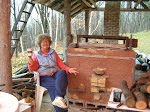The front section apart from a few pieces were loaded with MD shino and Wirtz shino as liner. The pots ended up blistered bubbled and cratered - both outside as well as inside!
 |
| MD Shino - super crusty disaster - top shelf front section |
So what happened?
1. Did the flames over fire the shinos and cause the blistering? I didn't think that shinos could over fire - they seem to be able to take a lot of heat - plus some of the liner glazes were underfired in that section - indicating not over-firing.
2. Was everything under fired and so the glaze did not have time to smooth out? I did not think that shinos do much bubbling during melting - but I could be wrong as they definitely bubble over other glazes. But on some pots the side away from the flames had some smooth melted surfaces. I would assume that the side away from the flames would remain cooler.
3. This was the first time that I had used some calcined kaolin and ball clay to replace some of the clay so as to reduce crawling. Did that affect the glaze? Did I mix up the glaze wrong? I used the same glaze on other pots in the middle section and the shino there was good though still a bit underfired in parts so that was not the cause.
4. Did I over reduce? - I was trying for lots of carbon trapping - so threw in everything at the start to build up soot - lots of pine boughs with needles on them as well as lots of little twigs on top of the logs.
5. Did reduction cooling occur? - not sure what happens with shino in reduction cooling, but there was some reduction cooling I think as the ember pile was still huge when I clammed up the kiln.
6. The front section pots were placed in the kiln anywhere from 5 to 3 days prior to the firing and there was rain during that time. The pots were protected from the rain as the kiln is under a shed roof - however it is located high in the Opeongo mountains where we often drive up into the fog. The few sides of pots that were away from the flames were smooth and these would have been protected from the prevailing winds (moisture) as well. I think that the pots reabsorbed moisture from the moist air and the glaze blistered up very slightly - not enough to be readily visible - as I had repositioned some of those pots just prior to firing and I would have noticed that something was wrong with the glaze.
Something like this happened once before with a MD shino pot that I had left out in the open - it was very foggy overnight and the next day the raw glaze had bubbled up. I fired it but the bubbles did not smooth out and these pots reminded me of that same effect.
 |
| Tray in top layer for front section - MD shino - all bubbled . |
 |
| Small smooth sections on two bowls - sections were facing away from the flames. |
So I think I will have to take out the hard brick and put back the insulating bricks and make sure that I load the shinos just prior to firing.
Pots I can make more - but the stack of dry wood was diminished and that is harder and less fun to replace.













No comments:
Post a Comment